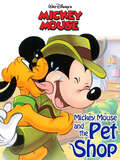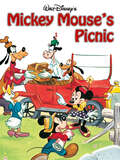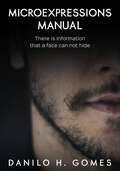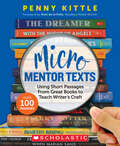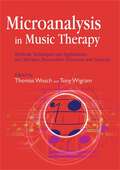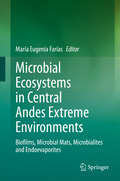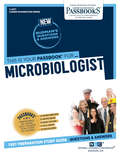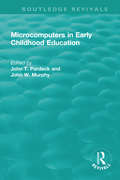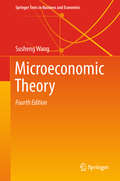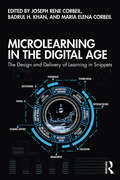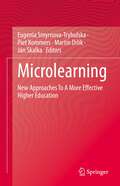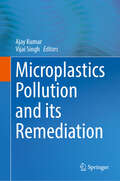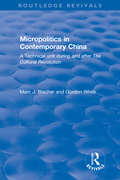- Table View
- List View
Mickey Mouse and the Pet Shop
by DISNEY BOOK GROUPMickey works at a pet shop and takes care of a troublesome puppy.
Mickey Mouse's Picnic
by Disney Book GroupOne beautiful summer day, Mickey and Minnie Mouse decide to go on a picnic! They invite Pluto, Goofy, Daisy Duck, and Clarabelle Cow. They do not invite Donald Duck...something always goes wrong when he is around! When they drive away, no one notices that Donald saw them leave him behind! So when the friends reach the picnic grounds, they decide to go have fun before eating. But when they return, their picnic basket disappeared! Where could it have gone?
Mickey Saves Santa
by Disney PressMickey and his friends are all ready for a Christmas Eve sleepover at the Clubhouse. They've written their lists and can't wait for Santa Claus to arrive. But there's a big problem at the North Pole and Santa won't be coming unless he gets some help. Join your favorite Clubhouse friends as they set out to save the day and rescue Christmas.
Mickey and the Beanstalk
by Disney Book GroupIn Happy Valley, the sun is always shining and everything is pretty and green. A magical harp sings a beautiful song, casting a spell of peace over the valley. But when the harp suddenly disappears, Happy Valley turns dark, and everything stops working and growing. Farmer Mickey, Farmer Donald, and Farmer Goofy are awfully hungry, so when Mickey decides to sell their cow in exchange for food, he returns with three magic beans! Don't miss this retelling of the classic tale of Jack and the Beanstalk—with a Disney twist!
Mickey and the Roaster Racers: Catch that Fish! / ¡Atrapa ese pez! (English-Spanish)
by Disney Book GroupFollow along with Mickey and his friends in this English-Spanish bilingual storybook. Mickey Mouse y Goofy están muy emocionados por su viaje de pesca anual, pero cuando sus amigos deciden unirse a ellos, ¡la tranquila excursión de Goofy y Mickey se convierte en una misión de rescate! Mickey Mouse and Goofy are excited for their annual fishing trip. But when the other Roadster Racers decide to join them, Mickey and Goofy’s quiet outing turns into a rescue mission!
Mickey’s Christmas Carol
by DISNEY BOOK GROUPBah, humbug! Ebenezer Scrooge doesn’t understand why everyone is so cheerful around Christmas time. Rich and greedy, Scrooge doesn't even want to let his clerk, Bob Cratchit, spend time with his family on Christmas Eve. But when Scrooge goes home late one night, a ghost tells him that he will be visited by three spirits—and that he must listen to what they have to say. Will Scrooge be able learn the true meaning of Christmas, or will he be greedy and lonely forever? Don't miss this retelling of the classic tale of A Christmas Carol—with a Disney twist!
Micky's Magic Pencil (Early Reader)
by Vivian FrenchEarly Readers are stepping stones from picture books to reading books. A blue Early Reader is perfect for sharing and reading together. A red Early Reader is the next step on your reading journey.Mickey's gran has sent him a magical pencil. It's red and yellow and blue and green, and Mickey can't wait to use it. But there always seems to be someone who needs the help of its magic powers more than Mickey does...A lovely story about friendship and togetherness, told in Vivian French's heartwarming style. With full colour illustrations on every page from Sarah Jennings, MICKY'S MAGIC PENCIL is guaranteed to delight.
Micro Expressions Manual: There is information that a face can not hide
by Danilo H. GomesBody language is one of the most complex and effective studies in psychology and psychiatry. Reading human gesture techniques are present in police investigations, psychotherapy clinics, schools and other related places. While generally being assertive, observing body gestures can provide some confusing and ambiguous information. When dealing with micro facial expressions, the chances of getting it right are very high, in addition, your observation provides more accurate information.
Micro Mentor Texts: Using Short Passages From Great Books To Teach Writer's Craft
by Penny KittleAt a time when students' attention is being pulled in many directions, writing expert Penny Kittle shows us the power of helping them to focus in and communicate clearly. She does that through the study of "micro mentor texts," excerpts from acclaimed books, and the decisions authors make to craft those texts so they deeply engage readers. Her book includes dozens of short texts and mini-lessons based on them--as well as many practice opportunities for students and demonstration videos for you.
Micro-Life Student Book
by National Science FoundationAs you examine the activities in this book, you may wonder, "Why does this book look so different from other science books I've see?"The reason is simple: it is a different kind of science program, and only some of what you will learn can be seen by leafing through this book!
Microaggression Theory: Influence and Implications
by Derald Wing Sue Kevin L. Nadal Gina C. Torino David P. Rivera Christina M. CapodilupoGet to know the sociopolitical context behind microaggressions Microaggressions are brief, everyday exchanges that send denigrating messages to certain individuals because of their group membership (e.g., race, gender, culture, religion, social class, sexual orientation, etc.). These daily, common manifestations of aggression leave many people feeling vulnerable, targeted, angry, and afraid. How has this become such a pervasive part of our social and political rhetoric, and what is the psychology behind it? In Microaggression Theory, the original research team that created the microaggressions taxonomy, Gina Torino, David Rivera, Christina Capodilupo, Kevin Nadal, and Derald Wing Sue, address these issues head-on in a fascinating work that explores the newest findings of microaggressions in their sociopolitical context. It delves into how the often invisible nature of this phenomenon prevents perpetrators from realizing and confronting their own complicity in creating psychological dilemmas for marginalized groups, and discusses how prejudice, privilege, safe spaces, and cultural appropriation have become themes in our contentious social and political discourse. Details the psychological effects of microaggressions in separate chapters covering clinical impact, trauma, related stress syndromes, and the effect on perpetrators Examines how microaggressions affect education, employment, health care, and the media Explores how social policies and practices can minimize the occurrence and impact of microaggressions in a range of environments Investigates how microaggressions relate to larger social movements If you come across the topic of microaggressions in your day-to-day life, you can keep the conversation going in a productive manner—with research to back it up!
Microanalysis in Music Therapy: Methods, Techniques and Applications for Clinicians, Researchers, Educators and Students
by Tony Wigram Barbara L Wheeler Thomas WoschIn the context of music therapy, microanalysis is the detailed analysis of that short period of time during a music therapy session during which some kind of significant change takes place. These moments are crucial to the therapeutic process, and there is increasing interest amongst music therapists in understanding how they come about and whether there are ways of initiating them. The contributors to this groundbreaking book look at methods of micro process analyses used in a variety of music therapy contexts, both clinical and research-based. They outline their methods, which include using video and audio materials, interviewing, and monitoring the client's heart rate, and also give examples of the practical application of microanalysis from their clinical experience, including work with clients who have psychiatric illness, autism and other conditions. Microanalyses in Music Therapy provides a wealth of important theoretical and practical information for music therapy clinicians, educators and students.
Microbial Ecosystems in Central Andes Extreme Environments: Biofilms, Microbial Mats, Microbialites and Endoevaporites
by María Eugenia FaríasThe Central Andean Altiplane represents a unique extreme environment due to its high altitude, closed basins that modulate the salt pans and saline wetlands surrounded by deserts, as well as the considerable influence of volcanic activity. UV radiation, arsenic content, high salinity, alkalinity and low dissolved oxygen levels, together with extreme daily temperature fluctuations and oligotrophic conditions, shape an environment that resembles the early Earth and, even more, extraterrestrial conditions. By developing simple biofilms stratified microbial mats or complex microbialites, extreme microbial ecosystems, colonize and thrived in different environments like salt flats, wetlands, lakes volcano vents, geysers and deserts. This book presents our current understanding of these amazing ecosystems, providing a basis for their protection and sustainable utilization. The main audience for this book included researchers and graduate students as well as professionals working in the government, mining industry and similar activities.
Microbiologist: Passbooks Study Guide (Career Examination Series #C-1945)
by National Learning CorporationThe Microbiologist Passbook® prepares you for your test by allowing you to take practice exams in the subjects you need to study. It provides hundreds of questions and answers in the areas that will likely be covered on your upcoming exam.
Microcase - Una Guida Per Principianti Al Vivere In Piccolo
by F. Rossi J. R. ShepherdVivi bene vivendo in piccolo!Ti sei mai chiesto come sarebbe vivere in una microcasa? Sogni di avere un mutuo più basso, o di non averne nessuno? Vuoi vivere "verde"? Vuoi vivere un po' più semplicemente e concentrarti sulle cose realmente importanti della vita? Allora una microcasa può essere la soluzione perfetta per te!Questo libro esplora le microcase e lo stile di vita che le accompagna. Ti farà capire se le microcase vanno bene per te, e ti aiuterà ad arrivare a vivere in grande in uno spazio piccolo.In "Microcase - Una guida per principianti al vivere in piccolo" troverai:- Per chi sono adatte le microcase- Come le microcase ti possono aiutare a limitare le cose che possiedi inutili ed a concentrarti su quelle realmente importanti- Dei suggerimenti per progettare e decorare in modo da sfruttare al massimo la tua microcasa- I benefici fisici ed emotivi di adottare lo stile di vita delle microcase- E molto altro ancora!Vivere in una microcasa vuol dire concentrarti su quello che è realmente importante: le relazioni, gli hobby, il lavoro, la natura o la comunità. Non è mai troppo tardi per cambiare, e "Microcase - Una guida per principianti al vivere in piccolo" ti aiuterà ad arrivarci!Vivi bene vivendo in piccolo!
Microcomputers in Early Childhood Education (Routledge Revivals)
by John W. Murphy John T. PardeckOriginally published in 1989, this book differed from others on the topic of microcomputers and education at the time, in that it focuses on the influence that microcomputer technology has on children in their early years, specially pre-school and elementary ages. Microcomputers have the capacity to do great harm as well as good and a full explanation of the technical and philosophical issues involved will be of interest to a number of disciplines. Other topics explored are – the potential uses of microcomputer-technology in early childhood education and current research and theory building on microcomputers and early education. This book should be read by teachers, sociologists, psychologists and researchers in education.
Microeconomic Theory (Springer Texts in Business and Economics)
by Susheng WangThis book covers microeconomic theory at the Master’s and Ph.D levels for students in business schools and economics departments. It concisely covers major mainstream microeconomic theories today, including neoclassical microeconomics, game theory, information economics, and contract theory. The revamped, 3rd edition of "Microeconomic Theory" offers faculty, graduate and upper undergraduate students with a comprehensive curriculum solution.
Microlearning in the Digital Age: The Design and Delivery of Learning in Snippets
by Joseph Rene CorbeilMicrolearning in the Digital Age explores the design and implementation of bite-sized learning and training in technology-enabled environments. Grounded in research-based best practices and a robust, eight-dimensional framework, this book applies the latest developments in mobile learning, social media, and instructional/multimedia design to one of today’s most innovative and accessible content delivery systems. Featuring experts from higher education, information technology, digital gaming, corporate, and other contexts, this comprehensive guide will prepare graduate students, researchers, and professionals of instructional design, e-learning, and distance education to develop engaging, cost-effective microlearning systems.
Microlearning: New Approaches To A More Effective Higher Education
by Piet Kommers Eugenia Smyrnova-Trybulska Martin Drlík Ján SkalkaThis book is about the most significant developments in the field of microlearning in the teaching of programming. In particular, the book covers the creation of content and the use of microlearning activities for automatically evaluating programming assignments. These critical component of microlearning represent a significant contribution both in fulfilling individual project objectives and in improving computer programming education in general. The book is interdisciplinary, examining both computer science and education. Specific topics explored include: development of distance courses, creating microcourses, fostering interdisciplinary knowledge, IT, management, and theoretical, methodological and practical aspects of the implementation of microlearning. Additionally, comprehensive analysis of the scientific literature (monographs, articles, proceedings) on the subject of the project and conducted research is provided.
Microplastics Pollution and its Remediation
by Ajay Kumar Vijai SinghThe book elaborates on microplastics as a global concern, prompting the need for comprehensive understanding and effective management. It thoroughly explores the various aspects of microplastics, addressing their detection, separation, and contamination in diverse ecosystems. The introductory chapter highlights the global risks associated with microplastics while presenting the challenges and opportunities in tackling this issue. It focuses on the detection techniques employed to identify microplastics, providing insights into the analytical methods and technologies utilized in their characterization. It delves into the separation techniques used to extract microplastics from complex environmental matrices, aiding in their accurate quantification and analysis. The subsequent chapters examine the presence and impact of microplastics in specific ecosystems, including aquatic and terrestrial. It investigates the prevalence of microplastics in water bodies and their detrimental effects on aquatic organisms and elucidates their distribution, transport, and ecological implications on land-dwelling organisms. The book further explores microplastics' occurrence in foods, cosmetics, and air pollution and associated health hazards. It delves into the lesser-known aspects of microplastics influence on nitrogen cycling and nitrous oxide emissions, offering valuable insights into their impact on biogeochemical processes. It discusses microplastics environmental risks and hazards, covering the ecological, biodiversity, and ecosystem-level impacts caused by these persistent pollutants. The concluding chapters focus on sustainable management strategies for mitigating and controlling microplastics proliferation and associated risks. This book provides a comprehensive and multidisciplinary approach for understanding and addressing the challenges posed by microplastics. It serves as a valuable resource for researchers, policymakers, environmentalists, and anyone concerned about the impact of microplastics on planet. This book aims to foster sustainable management practices and contribute to a cleaner and healthier environment by unraveling microplastics complexities.
Micropolitics in Contemporary China: A Technical Unit During And After The Cultural Revolution (Routledge Revivals)
by Gordon White Marc J. BlecherThis title was first published in 1980. One of the most prevalent and significant issues facing socialist countries is the role of intellectuals. In the poorer countries like China, this has presented itself with particular acuity in the relationship of scientists and technicians to the process of socialist economic modernization. Since the Cultural Revolution has come to a close, its impact on China’s intellectual life— especially on scientists, technicians, and the development of scientific and technical work— has been the subject of lively inquiry in China. In turn, this inquiry has provided a major focus for reevaluating the Cultural Revolution as a political movement and as a way of dealing with the inequalities and bureaucratic inefficiencies that have arisen and will continue to arise in the centrally planned Chinese economy during a period when rapid economic growth and modernization have been given the highest priority. This monograph intends to address some of these issues by presenting a detailed case study of a Chinese technical unit over the period from 1966 to 1974.
Microscopic Wonders: The Science of Seeing the Invisible
by Abraham Rosas-Arellano Carmen Reyes Luna Fabiola García-Zamorategui Ricardo Piña-Muñoz Yazmín Ramiro-Cortés Gerardo Rodrigo Perera-Murcia Alfonso Cárabez-TrejoThis book takes the reader on a visual journey of the microscope and shares exciting stories about its development and the new technologies that exist that renders the invisible visible. The book begins with the history of microscopy and follows with the basics of various types of microscopy: brightfield, widefield, confocal, transmission electron, and scanning electron. All chapters feature stunning visuals. The history of the microscope is illustrated with paintings in the style of tattoos by tattoo artist Yingfayang tattoo, and the later chapters pair computer designed images and photography to stunning effect, passing on to the reader an appreciation not only for the scientific possibilities of microscopy, but also its artistic possibilities.
Microscopy Techniques for Biomedical Education and Healthcare Practice: Principles in Light, Fluorescence, Super-Resolution and Digital Microscopy, and Medical Imaging (Biomedical Visualization #2)
by Leonard ShapiroThis edited book has a strong focus on advances in microscopy that straddles research, medical education and clinical practice. These advances include the shift in power from conventional to digital microscopy. The first section of this book covers imaging techniques and morphometric image analysis with its applications in biomedicine using different microscopy modes. Chapters highlight the rich development of fluorescence methods and technologies; particle tracking techniques with applications in biomedical research and nanomedicine; the way in which visualizations have revolutionized taxonomy from gross anatomy to genetics; and the psychology of perception and how it affects our understanding of cells and tissues. The book’s first section concludes by exploring the use of CT modalities to evaluate anterior deformities in craniosynostosis. In the second section of the book, chapters on anatomical and cell biology education explore the history of anatomical models and their use in educational settings. This includes examples in 3D printing and functional human anatomical models that can be created using easily available resources and the use of biomedical imaging in visuospatial teaching of anatomy; the novel use of ultrasound in medical education and practice; and skill acquisition in histology education using a flowchart called a ‘decision tree’. This book will appeal to histologists, microscopists, cell biologists, clinicians and those involved in anatomical education and biomedical visualization, as well as students in those respective fields.
Microsoft 365 Security Administration: Plan and implement security and compliance strategies for Microsoft 365 and hybrid environments
by Peter RisingGet up to speed with expert tips and techniques to help you prepare effectively for the MS-500 Exam Key Features Get the right guidance and discover techniques to improve the effectiveness of your studying and prepare for the exam Explore a wide variety of strategies for security and compliance Gain knowledge that can be applied in real-world situations Book Description The Microsoft 365 Security Administration (MS-500) exam is designed to measure your ability to perform technical tasks such as managing, implementing, and monitoring security and compliance solutions for Microsoft 365 environments. This book starts by showing you how to configure and administer identity and access within Microsoft 365. You will learn about hybrid identity, authentication methods, and conditional access policies with Microsoft Intune. Next, the book shows you how RBAC and Azure AD Identity Protection can be used to help you detect risks and secure information in your organization. You will also explore concepts, such as Advanced Threat Protection, Windows Defender ATP, and Threat Intelligence. As you progress, you will learn about additional tools and techniques to configure and manage Microsoft 365, including Azure Information Protection, Data Loss Prevention, and Cloud App Discovery and Security. The book also ensures you are well prepared to take the exam by giving you the opportunity to work through a mock paper, topic summaries, illustrations that briefly review key points, and real-world scenarios. By the end of this Microsoft 365 book, you will be able to apply your skills in the real world, while also being well prepared to achieve Microsoft certification. What you will learn Get up to speed with implementing and managing identity and access Understand how to employ and manage threat protection Get to grips with managing governance and compliance features in Microsoft 365 Explore best practices for effective configuration and deployment Implement and manage information protection Prepare to pass the Microsoft exam and achieve certification with the help of self-assessment questions and a mock exam Who this book is for This Microsoft certification book is designed to help IT professionals, administrators, or anyone looking to pursue a career in security administration by becoming certified with Microsoft's role-based qualification. Those trying to validate their skills and improve their competitive advantage with Microsoft 365 Security Administration will also find this book to be a useful resource.
Microsoft Azure AI Fundamentals AI-900 Exam Guide: Gain proficiency in Azure AI and machine learning concepts and services to excel in the AI-900 exam
by Steve Miles Aaron GuilmetteGet ready to pass the certification exam on your first attempt by gaining actionable insights into AI concepts, ML techniques, and Azure AI services covered in the latest AI-900 exam syllabus from two industry experts Key FeaturesDiscover Azure AI services, including computer vision, Auto ML, NLP, and OpenAIExplore AI use cases, such as image identification, chatbots, and moreWork through 145 practice questions under chapter-end self-assessments and mock examsPurchase of this book unlocks access to web-based exam prep resources, including mock exams, flashcards, and exam tipsBook DescriptionThe AI-900 exam helps you take your first step into an AI-shaped future. Regardless of your technical background, this book will help you test your understanding of the key AI-related topics and tools used to develop AI solutions in Azure cloud. This exam guide focuses on AI workloads, including natural language processing (NLP) and large language models (LLMs). You’ll explore Microsoft’s responsible AI principles like safety and accountability. Then, you’ll cover the basics of machine learning (ML), including classification and deep learning, and learn how to use training and validation datasets with Azure ML. Using Azure AI Vision, face detection, and Video Indexer services, you’ll get up to speed with computer vision-related topics like image classification, object detection, and facial detection. Later chapters cover NLP features such as key phrase extraction, sentiment analysis, and speech processing using Azure AI Language, speech, and translator services. The book also guides you through identifying GenAI models and leveraging Azure OpenAI Service for content generation. At the end of each chapter, you’ll find chapter review questions with answers, provided as an online resource. By the end of this exam guide, you’ll be able to work with AI solutions in Azure and pass the AI-900 exam using the online exam prep resources.What you will learnDiscover various types of artificial intelligence (AI)workloads and services in AzureCover Microsoft's guiding principles for responsible AI development and useUnderstand the fundamental principles of how AI and machine learning workExplore how AI models can recognize content in images and documentsGain insights into the features and use cases for natural language processingExplore the capabilities of generative AI servicesWho this book is forWhether you're a cloud engineer, software developer, an aspiring data scientist, or simply interested in learning AI/ML concepts and capabilities on Azure, this book is for you. The book also serves as a foundation for those looking to attempt more advanced AI and data science-related certification exams (e.g. Microsoft Certified: Azure AI Engineer Associate). Although no experience in data science and software engineering is required, basic knowledge of cloud concepts and client-server applications is assumed.
